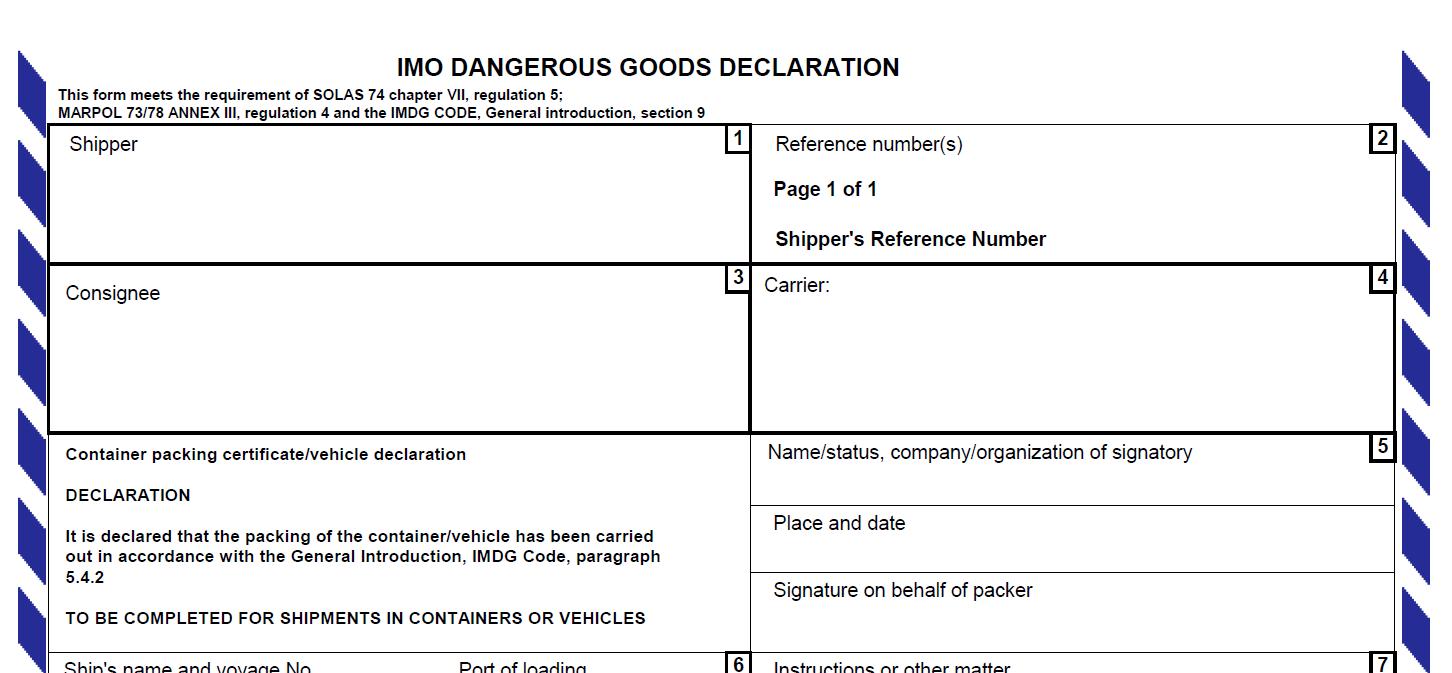|
|
Get a freight price in just a few clicks. Start by selecting your destination country from the list above. Our online freight calculator makes it easy to estimate your total international shipping costs while shipping goods from the USA.
Shipping Dangerous Goods
Dangerous Goods & the IMO Declaration for Cargo Transportation from the USA
When it comes to delivering goods overseas, certain types of cargo are regulated due to their potential risks. These are known as Dangerous Goods (D.G.) in maritime transport and are similar to Hazardous Materials (HAZMAT) used in air or ground transportation. If you ship anything hazardous, there's one essential document you’ll need: the IMO Dangerous Goods Declaration.
This declaration certifies that your cargo has been properly identified, packed, labeled, and documented in line with multinational maritime safety standards. Without it, your shipment will not be loaded, and attempting to ship hazardous goods without this declaration can lead to serious legal and safety consequences.

What Qualifies as Dangerous Goods?
Not all hazardous cargo is obvious. Before sending goods overseas, review your items for:
- Lithium-ion batteries (e.g., in electric bikes, laptops)
- Aerosol sprays, paint, or flammable liquids
- Car batteries and other corrosive substances
- Cleaning agents or pool chemicals
- Fireworks or explosive materials
If you’re sending any of the above, or aren’t sure whether your cargo qualifies, look for warning labels on packaging or consult the manufacturer. You can also call the U.S. Department of Transportation at 1-800-467-4922 for guidance.
What Does the Dangerous Goods Declaration Include?
The IMO Dangerous Goods Declaration must contain:
- Shipper and consignee details
- UN number
- Hazard class (e.g., Class 3 for flammables, Class 8 for corrosives)
- Packaging group
- Emergency contact info
- A signed declaration by the shipper confirming compliance with the IMDG Code standards
Shippers are responsible for completing this form and submitting it to the global cargo transportation company before container loading. Experienced global transportation companies should verify your paperwork to ensure compliance with the International Maritime Organization (IMO) regulations. If you're unsure how to fill it out, consult your freight forwarder or view online examples specific to ocean freight from the USA.
Carrier Restrictions on Dangerous Goods
Most sea freight carriers only accept dangerous goods in the following IMO classes:
- Class 3: Flammable liquids
- Class 8: Corrosive substances
- Class 9: Miscellaneous hazardous goods (like lithium batteries)
If your shipment falls outside these categories, you’ll need to find a specialized carrier licensed to handle other IMO classes. Always confirm this in advance to avoid rejections or delays. Segregation Requirements & Hold Harmless Letters
Certain hazardous materials must be segregated from other cargo during transportation to prevent dangerous chemical reactions. For example, water-reactive substances cannot be stored near liquids. These segregation rules exist to prevent accidents like fires, toxic gas releases, or explosions.
To comply with segregation requirements, you may need to provide a Hold Harmless Letter. This document, printed on your company’s letterhead, should state:
- You (the shipper) accept all liability for the cargo and its segregation
- The ocean carrier and its agents are not responsible for damage or loss during handling or separation
- You will cover any related segregation fees
- Clear instructions about which items require separation
Helpful Tips for First-Time Shippers
Don’t skip the declaration: Even small amounts of hazardous material must be declared. It’s a legal requirement.
Keep original documents: The Dangerous Goods Declaration and Hold Harmless Letter must be included in your file.
Use professional services: Some international shipping companies offer help with documentation or can complete declarations for a fee.
Request expert packing: For safety and compliance, cargo containing hazardous materials should be professionally packed and labeled.
Summary
If you ship internationally from the USA and your cargo includes hazardous items, you must be prepared with the correct paperwork and procedures in place. The Dangerous Goods Declaration ensures safety at sea, protects all parties involved, and facilitates the legal and efficient movement of your shipment, helping to avoid unexpected international shipping costs.
Whether you ship a battery-powered product or industrial chemicals, staying compliant helps you avoid delays, fines, or rejections. Work with a reliable global cargo transportation company, declare all items accurately, and include segregation instructions when necessary to ensure smooth delivery. With the proper planning, even complex freight involving hazardous goods can qualify for affordable international shipping. It’s all part of making cheap international shipping safe and successful.


.png)


